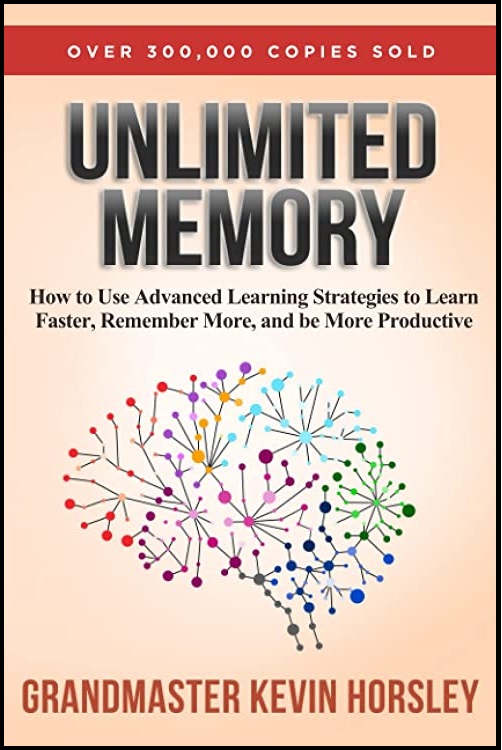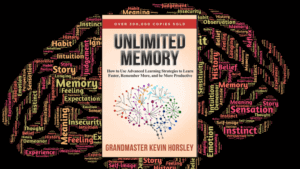I usually review books on all things fitness, health and nutrition but after reading this I had to share!
This book is by Kevin Horsley, a world record holder at memorising things. What kind of things? How about 10,000 digits of Pi? Not impressive enough? He learned it so thoroughly that when the examiners called out a five digit sequence, he correctly stated the five digits either side of it. The one thing that all memory champions like Kevin have in common is that they use specific methods to remember something. It’s these methods that are shared in the book, with plenty of chances to put it into practice.
So what can a regular person who doesn’t need to memorise Pi gain from the book? The methods can be applied to any scenario where information is needed for long term storage. The most obvious example would be school examinations, but once you understand the basic concepts it’s about finding as many scenarios as possible to apply them. Some of the methods are also suitable for smaller tasks, like remembering to take the bins out or what you need to buy at the shops.
Having fully embraced the methods and applied them myself I can confirm that it works really well. For example, I learned all 46 US presidents in around an hour, and can confidently recall them in order over a month later.
Unlimited Memory by Kevin Horsley

PRO TIP: Take notes! When you read a book, use a blank sheet of paper as a bookmark. Write down any interesting facts and information from the book. This condenses a whole book into 3-4 pages of key notes that are important and relevant to you.
My Notes
We have better memory for things that align with our P.I.C:
- Purpose: having a good reason for understanding the information
- Interest: being genuinely interested in the topic
- Curiosity: become curious about how your mind works when learning
The SEE principle relates to creating a visualisation in your mind to aid with memory. This is not possible for 1% of the population who suffer from aphantasia, and are unable to make a mental picture. For the rest of us, applying the SEE logic will make something more memorable:
- Senses: Engage all your senses. If you’re trying to remember a horse, imagine stroking it, smelling it, hearing it
- Exaggeration: It’s easier to remember something exaggerated. The horse could be purple or the size of a cat
- Energise: Add action to your visuals, the horse could gallop, or applying the previous principle, it could tap dance.
Abstract words can be converted into something memorable. The example given is the word hydrogen, which can be thought of as a mental image of a fire hydrant drinking gin. Hydrant-gin, hydrogen.
Two years after leaving school, the average person only remembers three weeks worth of lessons
Kevin Horsley, Unlimited Memory
Long Term Memory + Short Term Memory = Medium Term Memory. Leverage existing memories to aid recollection. For example, you should know the layout of your house. If you’re trying to remember a shopping list you could create a mental video of walking round your house, with items in specific locations e.g. baked beans in the bathtub.
Linking thoughts is good for remembering something in order. If you have ten things to remember in a specific order, have the second item interact in some way with the first, and so on.
Learning the 46 US Presidents in Order
Putting this all together, I learned the 46 US presidents in order. The first 12 are made into a story in the book, which I then extended to cover all presidencies. I’ll pick my story up from a theatre balcony, which I was using to remember Lincoln.
- The door to the main hall opens and through a smoky haze (Hayes) steps Garfield (Garfield) the cat, dressed as King Arthur (Arthur)
- The balcony then gives way, and they slowly slide off, similar to Cleveland (Cleveland) in one of the repeated jokes in Family Guy
- They land on a van, driven by a hairy sun (Harrison, this was used earlier in the story by the author) and the back slides open, where Cleveland (Cleveland) from Family Guy emerges
- He threatens to kill me (kill-me, McKinley) but before he does, the rooster (Roosevelt) from Family Guy pounces on him. Note: technically it’s a man in a chicken suit, but I know what I mean.
- The theatre floods, and the fight continues onto a raft (Taft). The raft flows out into the sea, landing on a desert island where they see Wilson (Wilson, Castaway reference)
- The beach on the island is full of people, and someone starts herding (Harding) them to the entrance of the island college (Coolidge). The entrance has a nice red carpet, but since people are walking sand everywhere it needs hoovered (Hoover).
- The rooster (Roosevelt) freaks out at the noise and sets sail again, this time going into stormy seas, reminiscent of Jim Carrey’s character in the Truman Show (Truman).
- Similar to the Truman Show, they hit a wall. This angers The Director, who is ultimately just a set of eyes in a tower (eyes-in-a-tower, Eisenhower). He crumples to the floor, clutching is kidneys (Kennedy) and his .. (Johnson).
I’ll not write it out in full as you should get the idea from here. Note the application of linked thoughts, so you only have to remember the next step in the story. I also use conversion for abstract words like Eisenhower, and long term memories from film & TV to build the story. It’s also pretty dramatic and silly, with a giant rooster, flooding and collapsing buildings.
If you have areas of your life or work where memorising information is required, I highly recommend this book.

